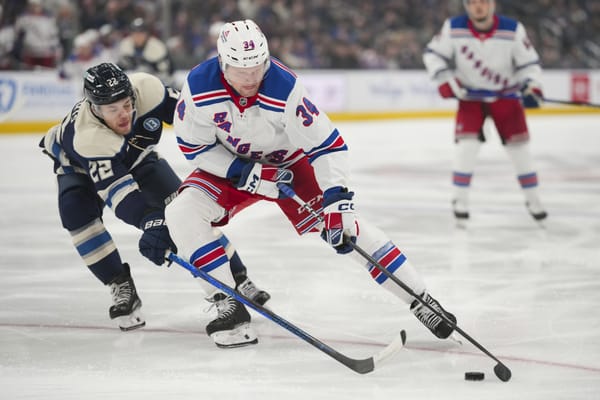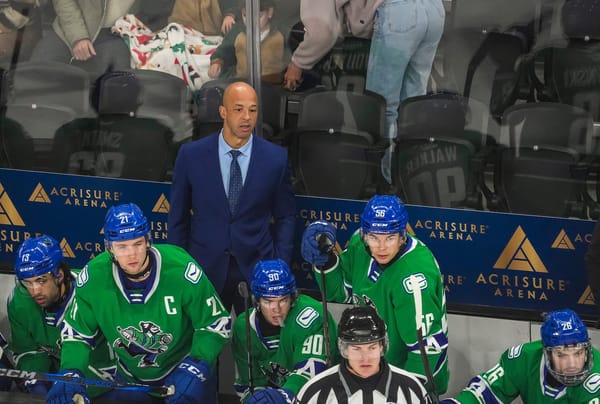Could This Rangers Team Be Different?
The Rangers’ strengths and weaknesses are clear. How might this year’s version be different from the playoff teams of yesteryear?
As a follow-up of sorts to my previous post about the Rangers’ strengths that have fueled their success so far this season, I now look further ahead at what could be in store for this year’s team, and how they compare to some of the common themes from their playoff runs with Henrik Lundqvist in net.
Top-Tier Talent and Special Teams Prowess
The New York Rangers’ keys to success, as detailed previously, are strong special teams and top-flight goaltending from Igor Shesterkin. Their overall five-on-five play in front of Shesterkin, however, has — to put it lightly — room for improvement.
There are thus some valid concerns the Shesterkin-led Rangers will be no different from the Henrik Lundqvist-led Rangers of yesteryear, in that they are doomed to fail in the postseason because their goalie can only carry them so far. While there is merit to those worries with the current state of the team, there are also some key differences to acknowledge.
Unlike the Lundqvist years, the Rangers boast a great deal of top-tier talent — even if their depth leaves something to be desired. Mika Zibanejad, Artemiy Panarin, Chris Kreider, Ryan Strome, and of course Adam Fox provided the Blueshirts with enough game-breaking ability to turn a close game in their favor.
On more than one occasion this season, the Rangers have played very poorly for the majority of a game, but were bailed out not only by their goaltending, but also by the playmaking talents of their top stars. One example that comes to mind is their Oct. 31 road victory over the Seattle Kraken early in the season. The Kraken took the play to the Rangers for most of the game, outshooting them 32-18. But with Shesterkin keeping the Rangers in the game, Panarin and Fox then took charge early in the third period. The duo combined for a beautiful, skillful goal that gave the Rangers the lead, which they would not relinquish.
Another example is from even earlier in the season, in a game where Shesterkin did not even play. With backup Alexandar Georgiev in net against the Ottawa Senators north of the border on Oct. 23, the Rangers looked sleepy for most of the matinee affair, and trailed 2-0 in the third period. Panarin and Kreider then connected to get the Rangers on the board with a power-play goal with just over five minutes remaining. The goal, which was created by two of the Rangers’ stars, woke the team up. The Rangers scored two more goals (one off a brilliant pass from Fox to Ryan Lindgren) and escaped with a 3-2 regulation win.
More recently, their 3-0 shutout win on Jan. 13 against the San Jose Sharks at the end of their California road trip was kickstarted by Zibanejad and Kreider striking for a shorthanded goal in the first period. Shesterkin took the Rangers home the rest of the way, along with some insurance goals in the third period.
This level of top-end talent is something the Rangers did not have consistently or to this degree during the Lundqvist years. Leaning on their power play is also new for them; during four seasons of the peak of the Lundqvist era (2011-12 through 2014-15), their power play never ranked higher than 15th (in 2013-14, when they advanced to the Stanley Cup Final), and ranked below 20th in three of the four seasons.
So, while some of the Rangers’ struggles and tendencies are familiar, they have some new weapons this time around.
Addressing Weaknesses
But, there are clear weaknesses too — weaknesses that have to be addressed sooner than later if this team wants to strike this postseason.
To address their obvious issue of depth below their top-tier talent, and to attempt to provide a boost to the team’s subpar even-strength play, general manager Chris Drury will likely be active leading up to the March 21 trade deadline. The Rangers should be in the market for a top-six and/or middle-six forward (let’s forget for a moment that this is largely a void of their own making after they traded Pavel Buchnevich in the offseason), and possibly a left-handed defenseman to serve as an upgrade over Patrik Nemeth, Libor Hajek, and Jarred Tinordi.
If (and that’s a big “if”) Drury makes the right moves, the Blueshirts might be better-suited to round out their even-strength game. They have enough game-breaking talent at the top of the lineup, and such decided advantages on special teams and in net that even just improving to become an average even-strength team would turn them into an extremely formidable playoff matchup.
Some might think that it’s a bit too early in the Rangers’ previously-declared rebuild for them to be aggressive buyers at the trade deadline. The counter-argument to that? Most of the players essential to their current success are in the primes of their careers. Shesterkin, while still fairly new to the NHL, is 26 after having spent a long time in the KHL. Zibanejad is 28, Panarin is 30, Kreider is 30, and Strome is 29. Fox is an exception, at 23.
The Blueshirts are also in the midst of a short window where they have the requisite cap space to make big (albeit short-term) moves at the trade deadline, before the big contract extensions Zibanejad and Fox kick in, and before they need to look towards re-signing some of their youngsters to bigger contracts. Thanks to the young, developing talent they’ve stocked over the past few years, the Rangers can be reasonably aggressive without undoing most of the progress they’ve made for the long term.
NYR have considerable (but not hellacious) cap limitations next season. They have total liberty to go out and get rentals this season; but for any acquisitions that aren't pure rentals(e.g. Kane, Toews, Chychrun)... it really depends what 2022-23 NYR assets/$ goes the other way. https://t.co/VIELsSIfxN
— HockeyStatMiner (@HockeyStatMiner) January 26, 2022
The Rangers’ flaws are obvious and well-documented. But those shortcomings should not overshadow their obvious and meaningful strengths. They can and should look to supplement those strengths by the trade deadline. While unlikely to completely resolve their issues, the right transactions might move the needle just enough to make the Rangers a more dangerous playoff team.





